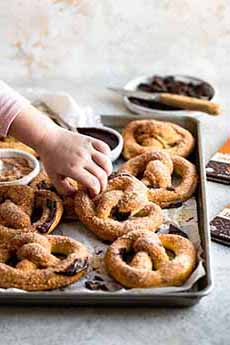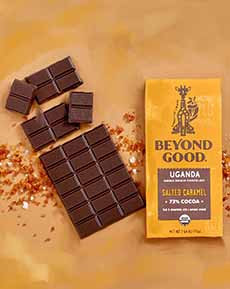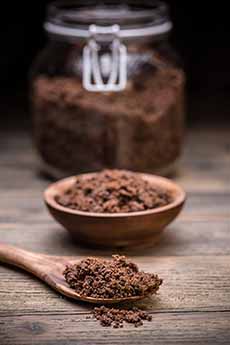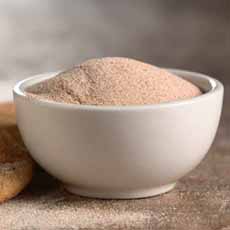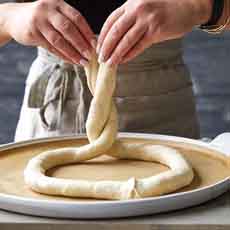Chocolate-Stuffed Soft Pretzels Recipe For National Soft Pretzel Month
|
|
April is National Soft Pretzel Month; April 26th is National Soft Pretzel Day. This year’s treat, a recipe for Chocolate-Stuffed Soft Pretzels, is compliments of Beyond Good, a producer of organic chocolate bars made with a rare heirloom variety of Madagascar cacao Beyond Good is a feel-good artisan brand. The world of cacao beans has long been structured so that too many middlemen walk away with too much of the profit, keeping the small farmers in poverty. Beyond Good has pioneered a trade model of sourcing heirloom cocoa directly from the farmers who grow it. Hopefully, more craft chocolate producers will follow, to change the industry, forever. Beyond Good sells chocolate and vanilla products. In addition to its cacao, Madagascar is one of the world’s great producers of vanilla—the variety known as Bourbon vanilla*. The company has expanded its ethically-sourced cacao with organic beans purchased directly from farmers in Bundibugyo, Uganda. Beyond Good products are available in stores nationwide and online at BeyondGood.com. There are more soft pretzel recipes below. The original pretzels were soft pretzels, baked by monks to encourage their students. Here’s the history of pretzels. These snack (or dessert!) pretzels are delicious and easy to make. They are stuffed with Beyond Good Salted Caramel Chocolate, a 73% cacao chocolate bar. If you prefer milk chocolate or lower-percentage-cacao dark chocolate, use the bar of your choice. You need 2.64 ounces or more. If you prefer a sweet-and-salty profile, you can sprinkle the warm pretzels with kosher salt or other coarse salt instead of cinnamon sugar. 1. MAKE the ganache first. Heat the heavy cream in the microwave for 30-40 seconds until it is hot, but not boiling. Pour it over the chopped chocolate bar and let it sit for 1 minute. Then whisk until the chocolate is melted and completely smooth. Set aside to come to room temperature, stir occasionally, it will thicken as it cools. 2. STIR together in the bowl of a stand mixer with the dough hook attachment, the warm water, and yeast. Let sit for 1 minute, then whisk in the brown sugar, and butter. 3. ADD the flour 1 cup at a time, then knead on medium for 4-5 minutes. If the dough is still sticky, add 2 tablespoons of flour at a time until you can press the dough with your finger and it bounces back. Cover with a towel and set in a warm spot for 15 minutes. 4. PREHEAT the oven to 400°F. Line two baking sheets with parchment paper, and prepare the baking soda bath by adding the water and baking soda to a large stockpot and bringing it to a low boil. 5. DIVIDE the dough into 12 equal pieces, then roll out into 24-inch ropes. Press the dough flat, then spoon the chocolate ganache down the center all the way down the dough. 6. FOLD the dough over and pinch to seal. Then using your hands, roll back into a rope. 7. FOLD into a pretzel, then dunk the pretzels one at a time into the baking soda bath for 30 seconds. Use a slotted spoon to remove the pretzels, shake off any excess water, then place 6 pretzels on each baking sheet. 8. Brush the pretzels with egg wash (1 egg mixed with 2 tablespoons water), then bake for 12-13 minutes. 9. REMOVE the pretzels when they are golden brown. Brush with melted butter and toss in the cinnamon sugar. Serve immediately. 10. The pretzels will keep on the counter, wrapped in plastic, for up to 3 days. *The term “Bourbon vanilla” refers to the vanilla beans’ provenance. They come from the Bourbon Islands, which include Madagascar, Mauritius, and Réunion. The name comes from the period when the island of Réunion was ruled by the Bourbon kings of France. Bourbon vanilla has no direct relation to Bourbon whiskey, which is named for Bourbon County in Kentucky. The county also took its name from the House of Bourbon, but otherwise has nothing to do with the vanilla beans. Bourbon County was the fifth county established in what would become Kentucky. It was carved out of Fayette County, Virginia, and was named by Virginia in honor of the French royal family who had provided military and financial assistance to the colonies during the Revolutionary War [source]. |
|
|
|
||
